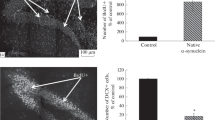Abstract
Rationale
Extrapyramidal motor signs are the major features of Parkinson’s disease (PD). It is unclear whether there is a link between these signs and such PD-associated factors as brain somatostatin deficiency and aging.
Objectives
This study aimed to examine whether an inhibition of the brain somatostatin system can initiate catalepsy, a model of extrapyramidal disorders, in young and aged rats.
Methods
The animals of 100–110 and 540–560 days of age were used. Catalepsy was measured using the bar test. The inhibition of the brain somatostatin activity was simulated by intracerebroventricular administration of a somatostatin antagonist, cyclosomatostatin.
Results
Cyclosomatostatin dose-dependently induced catalepsy in aged, but not in young rats. The cataleptic response was reversed by a somatostatin analog, octreotide.
Conclusions
The combination of aging and brain somatostatin deficiency can lead to catalepsy in rats. Since both factors are frequently observed in PD patients, the present results might be of relevance for pathogenesis of extrapyramidal signs in this disease.
Similar content being viewed by others
Change history
21 May 2022
An Editorial Expression of Concern to this paper has been published: https://doi.org/10.1007/s00213-022-06166-w
References
Antunes-Rodrigues J, McCann SM (1970) Water, sodium chloride, and food intake induced by injections of cholinergic and adrenergic drugs into the third ventricle of the rat brain. Proc Soc Exp Biol Med 133:1464–1470
Ben-Shlomo A, Zhou C, Pichurin O, Chesnokova V, Liu NA, Culler MD, Melmed S (2009) Constitutive somatostatin receptor activity determines tonic pituitary cell response. Mol Endocrinol 23:337–338
Chesselet MF, Reisine TD (1983) Somatostatin regulates dopamine release in rat striatal slices and cat caudate nuclei. J Neurosci 3:232–236
Costall B, Hui SC, Naylor RJ (1978) Correlation between multitest and single test catalepsy assessment. Neuropharmacology 17:761–764
Crocker AD, Hemsley KM (2001) An animal model of extrapyramidal side effects induced by antipsychotic drugs: relationship with D2 dopamine receptor occupancy. Prog Neuropsychopharmacol Biol Psychiatry 25:573–590
Dupont E, Christensen SE, Hansen AP, de Fine OB, Orskov H (1982) Low cerebrospinal fluid somatostatin in Parkinson disease: an irreversible abnormality. Neurology 32:312–314
Ehringer H, Hornykiewicz O (1960) Verteilung von Noradrenalin und Dopamin (3-Hydroxytyramin) im Gehirn des Menschen und ihr Verhalten bei Erkrankungen des extrapyramidalen Systems. Klin Wochenschr 38:1236–1239
Epelbaum J, Ruberg M, Moyse E, Javoy-Agid F, Dubois B, Agid Y (1983) Somatostatin and dementia in Parkinson’s disease. Brain Res 278:376–379
Erzin-Waters C, Muller P, Seeman P (1976) Catalepsy induced by morphine or haloperidol: effects of apomorphine and anticholinergic drugs. Can J Physiol Pharmacol 54:516–519
Feifel D, Minor KL (1997) Cysteamine blocks amphetamine-induced deficits in sensorimotor gating. Pharmacol Biochem Behav 58:689–693
Hindle JV (2010) Ageing, neurodegeneration and Parkinson’s disease. Age Ageing 39:156–161
Hornykiewicz O (1998) Biochemical aspects of Parkinson’s disease. Neurology 51(2 Suppl 2):S2–S9
Ikeda H, Kotani A, Koshikawa N, Cools AR (2009) Somatostatin receptors in the nucleus accumbens modulate dopamine-dependent but not acetylcholine-dependent turning behaviour of rats. Neuroscience 159:974–981
Klein MC, Gertner SB (1983) Studies on the mechanism of the cardiovascular action of central injections of histamine. Neuropharmacology 22:1109–1115
Lee N, Radke JM, Vincent SR (1988) Intra-cerebral cysteamine infusions attenuate the motor response to dopaminergic agonists. Behav Brain Res 29:179–183
Lin SS, Chan JY, Chan SH (1991) Facilitation of baroreceptor reflex response by endogenous somatostatin in the rat. Regul Pept 33:239–250
Marazioti A, Pitychoutis PM, Papadopoulou-Daifoti Z, Spyraki C, Thermos K (2008) Activation of somatostatin receptors in the globus pallidus increases rat locomotor activity and dopamine release in the striatum. Psychopharmacol (Berl) 201:413–422
Martin-Iverson MT, Radke JM, Vincent SR (1986) The effects of cysteamine on dopamine-mediated behaviors: evidence for dopamine-somatostatin interactions in the striatum. Pharmacol Biochem Behav 24:1707–1714
Masson H, Popescu I, Strubel D, Cramer H, Kuntzmann F (1990) Somatostatin-like immunoreactivity in the cerebrospinal fluid of aged patients with Parkinson’s disease. The effect of dopatherapy. J Am Geriatr Soc 38:19–24
Muzumdar RH, Ma X, Yang X, Atzmon G, Barzilai N (2006) Central resistance to the inhibitory effects of leptin on stimulated insulin secretion with aging. Neurobiol Aging 27:1308–1314
Ooka H, Fujita S, Yoshimoto E (1983) Pituitary-thyroid activity and longevity in neonatally thyroxine-treated rats. Mech Ageing Dev 22:113–120
Rakovska A, Javitt D, Raichev P, Ang R, Balla A, Aspromonte J, Vizi S (2003) Physiological release of striatal acetylcholine (in vivo): effect of somatostatin on dopaminergic–cholinergic interaction. Brain Res Bull 61:529–536
Sanberg PR, Pisa M, Fibiger HC (1981) Kainic acid injections in the striatum alter the cataleptic and locomotor effects of drugs influencing dopaminergic and cholinergic systems. Eur J Pharmacol 74:347–357
Spik K, Sonntag WE (1989) Increased pituitary response to somatostatin in aging male rats: relationship to somatostatin receptor number and affinity. Neuroendocrinology 50:489–494
Strittmatter M, Hamann GF, Strubel D, Cramer H, Schimrigk K (1996) Somatostatin-like immunoreactivity, its molecular forms and monoaminergic metabolites in aged and demented patients with Parkinson’s disease-effect of l-dopa. J Neural Transm 103:591–602
Unger J, Weindl A, Ochs G, Struppler A (1988) CSF somatostatin is elevated in patients with postzoster neuralgia. Neurology 38:1423–1427
Wadenberg ML, Soliman A, VanderSpek SC, Kapur S (2001) Dopamine D2 receptor occupancy is a common mechanism underlying animal models of antipsychotics and their clinical effects. Neuropsychopharmacology 25:633–641
Wang J, Guo Y, Cao DY, Luo R, Ma SJ, Wang HS, Pickar JG, Zhao Y (2009) Tonic inhibition of somatostatin on C and Aδ afferent fibers in rat dorsal skin in vivo. Brain Res 1288:50–59
Acknowledgements
I.D.I. is indebted to his teachers, Prof. Lev Aramovich Piruzyan and Prof. Igor Yefimovich Kovalev. Technical support of this research by “Timpharm Ltd.” (Moscow, Russia) is highly appreciated.
Author information
Authors and Affiliations
Corresponding author
Rights and permissions
About this article
Cite this article
Ionov, I.D., Pushinskaya, I.I. Somatostatin antagonist induces catalepsy in the aged rat. Psychopharmacology 227, 273–276 (2013). https://doi.org/10.1007/s00213-012-2961-0
Received:
Accepted:
Published:
Issue Date:
DOI: https://doi.org/10.1007/s00213-012-2961-0




